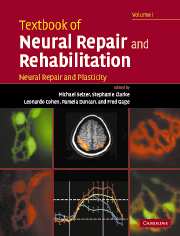Book contents
- Frontmatter
- Contents
- Contents (contents of Volume II)
- Preface
- Contributors (contributors of Volume I)
- Contributors (contributors of Volume II)
- Neural repair and rehabilitation: an introduction
- Section A Neural plasticity
- Section A1 Cellular and molecular mechanisms of neural plasticity
- Section A2 Functional plasticity in CNS system
- Section A3 Plasticity after injury to the CNS
- Section B1 Neural repair
- Section B2 Determinants of regeneration in the injured nervous system
- Section B3 Promotion of regeneration in the injured nervous system
- 25 Cell replacement in spinal cord injury
- 26 Dysfunction and recovery in demyelinated and dysmyelinated axons
- 27 Role of Schwann cells in peripheral nerve regeneration
- 28 Transplantation of Schwann cells and olfactory ensheathing cells to promote regeneration in the CNS
- 29 Trophic factor delivery by gene therapy
- 30 Assessment of sensorimotor function after spinal cord injury and repair
- Section B4 Translational research: application to human neural injury
- Index
30 - Assessment of sensorimotor function after spinal cord injury and repair
from Section B3 - Promotion of regeneration in the injured nervous system
Published online by Cambridge University Press: 05 March 2012
- Frontmatter
- Contents
- Contents (contents of Volume II)
- Preface
- Contributors (contributors of Volume I)
- Contributors (contributors of Volume II)
- Neural repair and rehabilitation: an introduction
- Section A Neural plasticity
- Section A1 Cellular and molecular mechanisms of neural plasticity
- Section A2 Functional plasticity in CNS system
- Section A3 Plasticity after injury to the CNS
- Section B1 Neural repair
- Section B2 Determinants of regeneration in the injured nervous system
- Section B3 Promotion of regeneration in the injured nervous system
- 25 Cell replacement in spinal cord injury
- 26 Dysfunction and recovery in demyelinated and dysmyelinated axons
- 27 Role of Schwann cells in peripheral nerve regeneration
- 28 Transplantation of Schwann cells and olfactory ensheathing cells to promote regeneration in the CNS
- 29 Trophic factor delivery by gene therapy
- 30 Assessment of sensorimotor function after spinal cord injury and repair
- Section B4 Translational research: application to human neural injury
- Index
Summary
Introduction
This chapter focuses on methods to assess postural and locomotor performance in laboratory animals. The main purpose is to identify the specific neuromotor deficits resulting from spinal cord injury (SCI) and those interventions that may be used to improve the level of recovery (see Volume I, Chapters 21–26, 28 and 29). Furthermore, we have focused on methods that reflect in vivo function. The methods include not only those which demonstrate the degree of motor dysfunction, but also those which provide some insight into the specific neural deficits that could account for the level of postural and locomotor performance.
In selecting methods to assess motor performance, the experimental design and the specific questions being addressed should be carefully considered. In the literature related to SCI over the past few years there has been the perception that there is a single test that can be used to define motor performance levels. In addition, there seems to have evolved the concept that the primary criteria for selecting a method of measurement of performance are that they can be easily and quickly administered, as well as inexpensive. Although such criteria can be rationalized in the clinical environment, in most cases this is not acceptable for drawing clear scientific conclusions. The view that a meaningful “measurement” can be validly and reliably derived from a visual impression to generate a rating of the performance of an animal in a minimally controlled environment has become pervasive in the area of SCI.
Keywords
- Type
- Chapter
- Information
- Textbook of Neural Repair and Rehabilitation , pp. 548 - 562Publisher: Cambridge University PressPrint publication year: 2006



